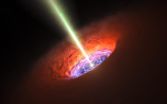Astronomers refer to these big galaxies as red and dead as they exhibit an ample abundance of ancient red stars, but lack young blue stars and show no evidence of new star formation. The estimated ages of the red stars suggest that their host galaxies ceased to make new stars about ten billion years ago. This shutdown began right at the peak of star formation in the Universe, when many galaxies were still giving birth to stars at a pace about twenty times faster than nowadays.
"Massive dead spheroids contain about half of all the stars that the Universe has produced during its entire life," said Sandro Tacchella of ETH Zurich in Switzerland, lead author of the article. "We cannot claim to understand how the Universe evolved and became as we see it today unless we understand how these galaxies come to be."
Tacchella and colleagues observed a total of 22 galaxies, spanning a range of masses, from an era about three billion years after the Big Bang [1]. The SINFONI instrument on ESO's Very Large Telescope (VLT) collected light fromthis sample of galaxies, showing precisely where they were churning out new stars. SINFONI could make these detailed measurements of distant galaxies thanks to its adaptive optics system, which largely cancels out the blurring effects of Earth's atmosphere.
The researchers also trained the NASA/ESA Hubble Space Telescope on the same set of galaxies, taking advantage of the telescope's location in space above our planet's distorting atmosphere. Hubble's WFC3 camera snapped images in the near-infrared, revealing the spatial distribution of older stars within the actively star-forming galaxies.
"What is amazing is that SINFONI's adaptive optics system can largely beat down atmospheric effects and gather information on where the new stars are being born, and do so with precisely the same accuracy as Hubble allows for the stellar mass distributions," commented Marcella Carollo, also of ETH Zurich and co-author of the study.
According to the new data, the most massive galaxies in the sample kept up a steady production of new stars in their peripheries. In their bulging, densely packed centres, however, star formation had already stopped.
"The newly demonstrated inside-out nature of star formation shutdown in massive galaxies should shed light on the underlying mechanisms involved, which astronomers have long debated," says Alvio Renzini, Padova Observatory, of the Italian National Institute of Astrophysics.
A leading theory is that star-making materials are scattered by torrents of energy released by a galaxy's central supermassive black hole asit sloppily devours matter. Another idea is that fresh gas stops flowing into a galaxy, starving it of fuel for new stars and transforming it into a red and dead spheroid.
"There are many different theoretical suggestions for the physical mechanisms that led to the death of the massive spheroids," said co-author Natascha Förster Schreiber, at the Max-Planck-Institut für extraterrestrische Physik in Garching, Germany. "Discovering that the quenching of star formation started from the centres and marched its way outwards is a very important step towards understanding how the Universe came to look like it does now."
INFORMATION:
Notes
[1] The Universe's age is about 13.8 billion years, so the galaxies studied by Tacchella and colleagues are generally seen as they were more than 10 billion years ago.
More information
This research was presented in a paper entitled "Evidence for mature bulges and an inside-out quenching phase 3 billion years after the Big Bang" by S. Tacchella et al., to appear in the journal Science on 17 April 2015.
The team is composed of Sandro Tacchella (ETH Zurich, Switzerland), Marcella Carollo (ETH Zurich), Alvio Renzini (Italian National Institute of Astrophysics, Padua, Italy), Natascha Förster Schreiber (Max-Planck-Institut für Extraterrestrische Physik, Garching, Germany), Philipp Lang (Max-Planck-Institut für Extraterrestrische Physik), Stijn Wuyts (Max-Planck-Institut für Extraterrestrische Physik), Giovanni Cresci (Istituto Nazionale di Astrofisica), Avishai Dekel (The Hebrew University, Israel), Reinhard Genzel (Max-Planck-Institut für extraterrestrische Physik and University of California, Berkeley, California, USA), Simon Lilly (ETH Zurich), Chiara Mancini (Italian National Institute of Astrophysics), Sarah Newman (University of California, Berkeley, California, USA), Masato Onodera (ETH Zurich), Alice Shapley (University of California, Los Angeles, USA), Linda Tacconi (Max-Planck-Institut für Extraterrestrische Physik, Garching, Germany), Joanna Woo (ETH Zurich) and Giovanni Zamorani (Italian National Institute of Astrophysics, Bologna, Italy).
ESO is the foremost intergovernmental astronomy organisation in Europe and the world's most productive ground-based astronomical observatory by far. It is supported by 16 countries: Austria, Belgium, Brazil, the Czech Republic, Denmark, France, Finland, Germany, Italy, the Netherlands, Poland, Portugal, Spain, Sweden, Switzerland and the United Kingdom, along with the host state of Chile. ESO carries out an ambitious programme focused on the design, construction and operation of powerful ground-based observing facilities enabling astronomers to make important scientific discoveries. ESO also plays a leading role in promoting and organising cooperation in astronomical research. ESO operates three unique world-class observing sites in Chile: La Silla, Paranal and Chajnantor. At Paranal, ESO operates the Very Large Telescope, the world's most advanced visible-light astronomical observatory and two survey telescopes. VISTA works in the infrared and is the world's largest survey telescope and the VLT Survey Telescope is the largest telescope designed to exclusively survey the skies in visible light. ESO is a major partner in ALMA, the largest astronomical project in existence. And on Cerro Armazones, close to Paranal, ESO is building the 39-metre European Extremely Large Telescope, the E-ELT, which will become "the world's biggest eye on the sky".
Links
Photos of the VLT: http://www.eso.org/public/images/archive/category/paranal/
Contacts
Sandro Tacchella
ETH Zurich
Zurich, Switzerland
Tel: +41 44 633 6314
Cell: +41 76 480 7963
Email: sandro.tacchella@phys.ethz.ch
Marcella Carollo
ETH Zurich
Zurich, Switzerland
Tel: +41 797 926 581
Email: marcella@phys.ethz.ch
Richard Hook
ESO, Public Information Officer
Garching bei München, Germany
Tel: +49 89 3200 6655
Cell: +49 151 1537 3591
Email: rhook@eso.org






